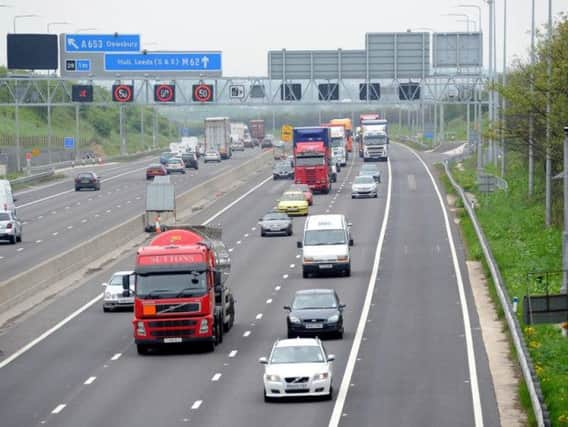Safety fears as hundreds of miles of hard shoulder converted into traffic lanes


All-lane running (ALR) schemes use the hard shoulder to ease the pressure on busy motorways and they have already been rolled out on dozens of miles of road.
There are currently just over 80 miles of ALR open to traffic but that figure is set to surge.
Advertisement
Hide AdAdvertisement
Hide AdAlmost 250 miles of ALR are set to be added to the road network by 2020 while almost 350 miles are due to be started but not finished up to 2020.
Meanwhile, there are also plans announced for just over 100 miles of ALR to be developed in the period between 2020 and 2025.
Shadow transport secretary Lilian Greenwood believes the Government needs to do more work to understand the implications of ALR.
“There are real concerns about the way all-lane running has been introduced on our motorways, without adequate evidence or consideration of the safety concerns raised by motoring organisations and the emergency services,” she said.
Advertisement
Hide AdAdvertisement
Hide Ad“The lack of public consultation also means that many drivers will be unaware of the changes to the way the road network operates.
“The Government need to address these issues before it is too late, rather than waiting for accidents to happen.”
ALR schemes can be used as part of a managed motorway or with the hard shoulder in full-time use, with refuge areas placed at regular intervals for people to use in an emergency.
The existing ALR schemes are on sections of the M25, M1 and M6, according to information published by the Department for Transport in response to written parliamentary questions from Ms Greenwood.
Advertisement
Hide AdAdvertisement
Hide AdThe Commons Transport Select Committee is currently conducting an examination of the safety of all-lane running schemes.
Louise Ellman, the chairman of the committee, told the Press Association: “We are about to start an inquiry in April. This is a major part of transport policy and we want to investigate whether all-lane running is effective and whether it is safe.
“The Government has clearly decided to do this but there is a need to look much more closely at whether it will be effective and whether it will be safe”.
Both the AA and the RAC have expressed concerns about all-lane running.
Advertisement
Hide AdAdvertisement
Hide AdRAC spokesman Simon Williams said: “While the RAC supports the principles of ‘smart’ motorways as the most cost-effective and rapid means of increasing capacity and reducing congestion, we would prefer to see the dynamic hard shoulder configuration used, where the hard shoulder is used as a running lane at busy times, as opposed to the all-lanes running one which leaves road users permanently without a hard shoulder.
“The decision to use an all-lanes running configuration as a default was taken before any trial took place, and although early signs show a cautious improvement on safety compared to a conventional three-lane and hard shoulder motorway, it is simply too early to make a judgment on doing away with almost 250 miles of motorway hard shoulder.”
Mr Williams also said the RAC is concerned the distance between refuge areas is “too great”.
“An RAC study showed that on the all-lanes running sections of the M25, only 42% of motorists who broke down were aware that emergency refuge areas existed, whilst only a meagre 28% could see one from where they broke down,” he said.
Advertisement
Hide AdAdvertisement
Hide Ad“This compares unfavourably to the dynamic hard shoulder sections of the M42, M1 and M6, where 56% were aware of the emergency refuge areas and 40% could see one when they broke down.”
Meanwhile the AA has raised its concerns about ALR with ministers and with the police.
It shares concerns with the RAC about the availability of refuge areas and the prospect of ALR creating “sitting duck” broken-down vehicles.
Edmund King, the president of the AA, believes the number of refuge areas needs to be doubled and they need to be increased in size.
Advertisement
Hide AdAdvertisement
Hide AdHe said: “The AA has consistently raised safety concerns regarding the new generation of ‘smart motorways’.
“We were so concerned that the AA Trust has designed its own free course, ‘Drive Motorway’, to help scared drivers cope with increased anxiety over using motorways without hard shoulders.”
Neil Greig, director of policy and research at the Institute of Advanced Motorists, said: “The IAM share concerns about safety of ALR and the onus is very much now on Highways England to prove they can be operated safely.
“The IAM want to see consistent enforcement of Red X violations and consideration of a specific driver awareness course for those drivers who break all-lane running rules.
Advertisement
Hide AdAdvertisement
Hide Ad“Constant ongoing awareness campaigns are also needed designed to reach occasional users as the holiday season approaches.”
A Highways England spokesman said: “Our motorways are some of the safest in the world, and there is evidence to show that where all lane running has been introduced, there have been fewer collisions and congestion has reduced.
“As we gradually roll out these upgrades on our motorways, we will continue to evaluate all lane running schemes and work closely with all the emergency services to ensure safety is maintained.”